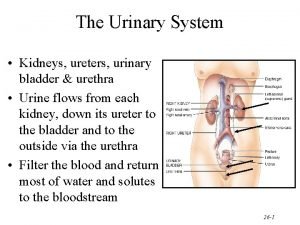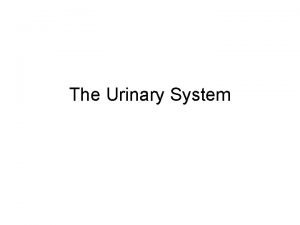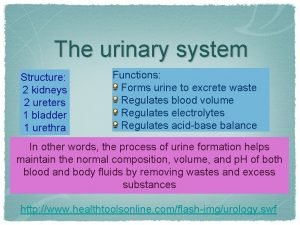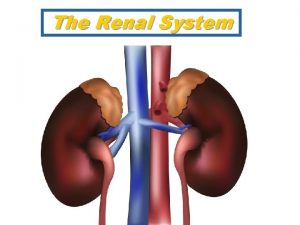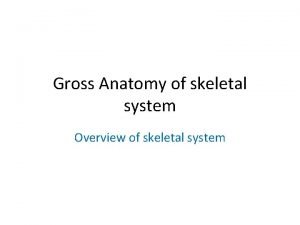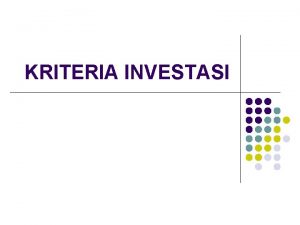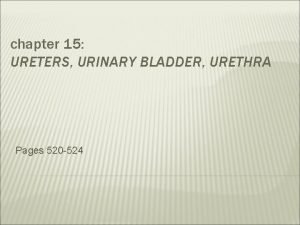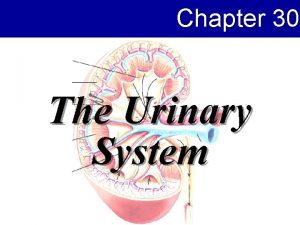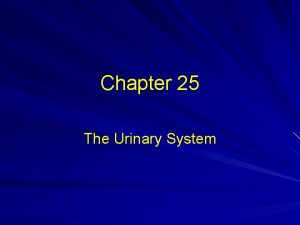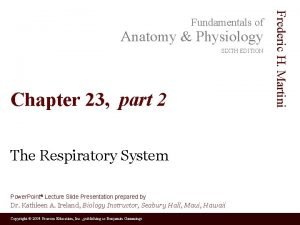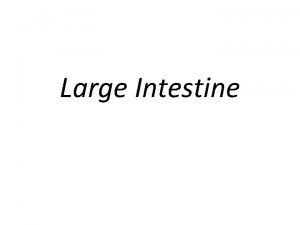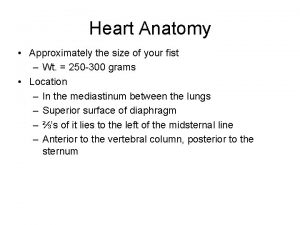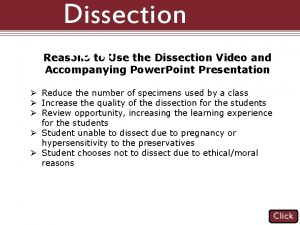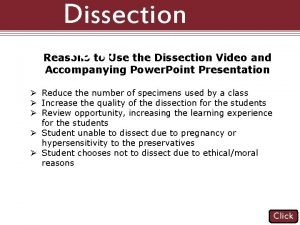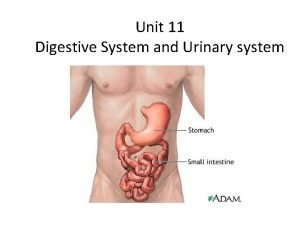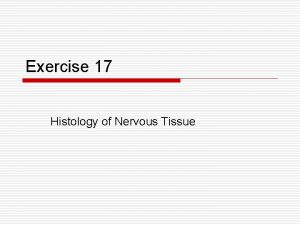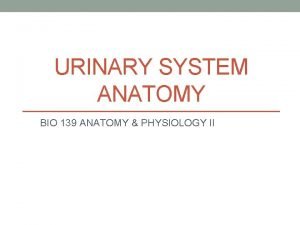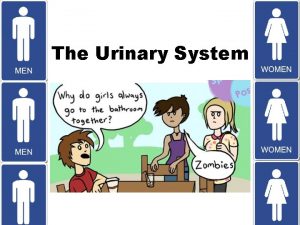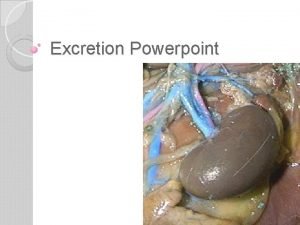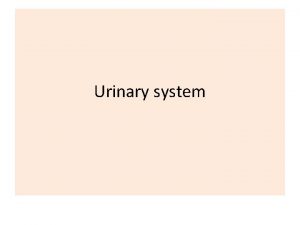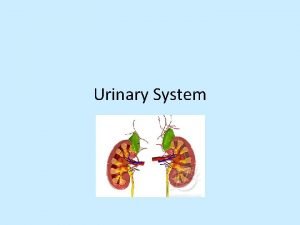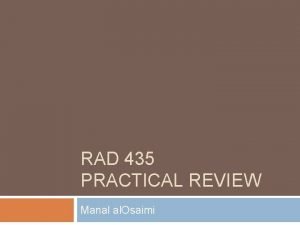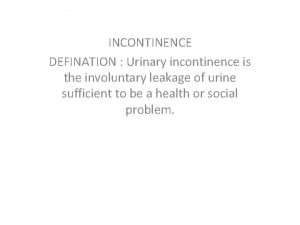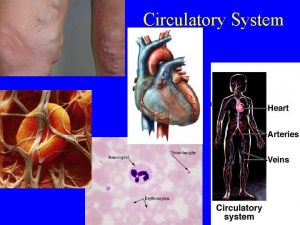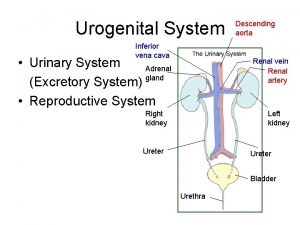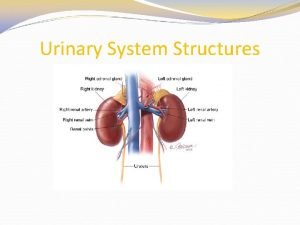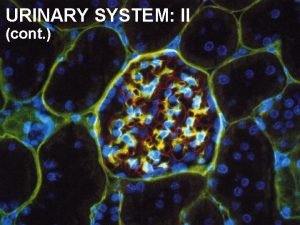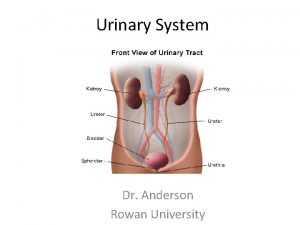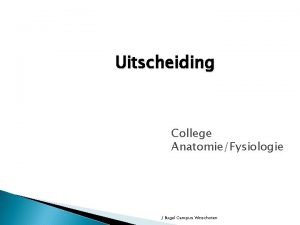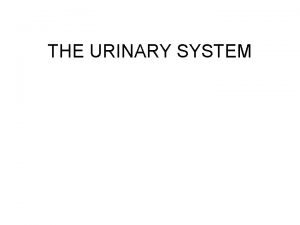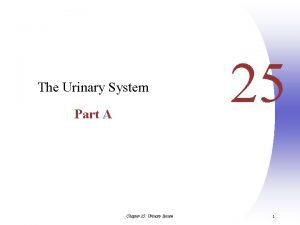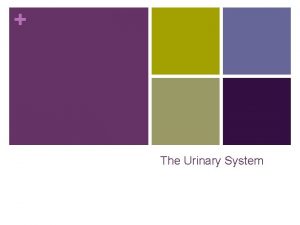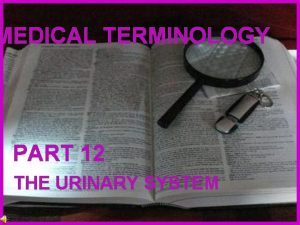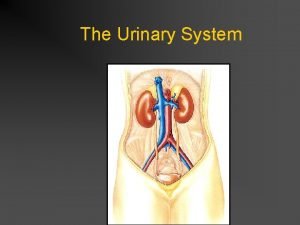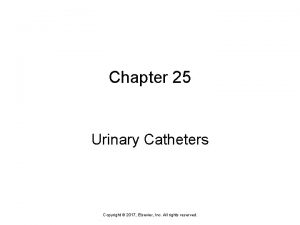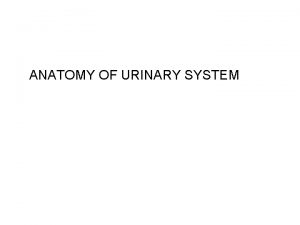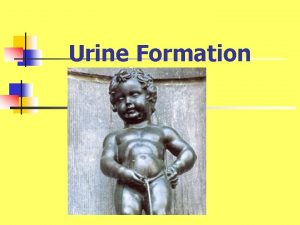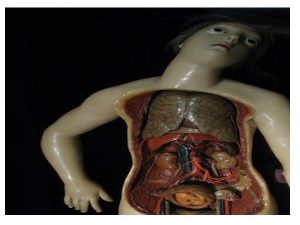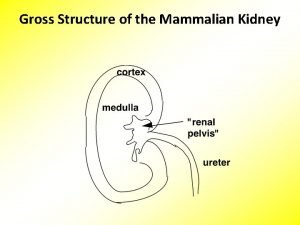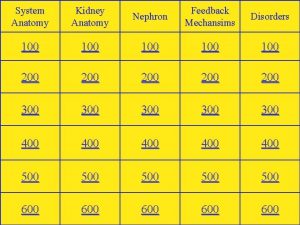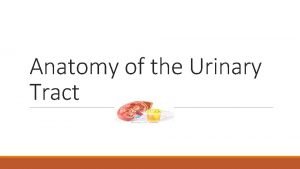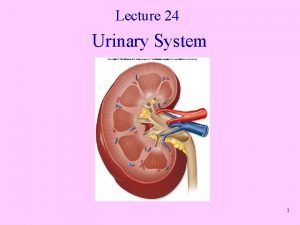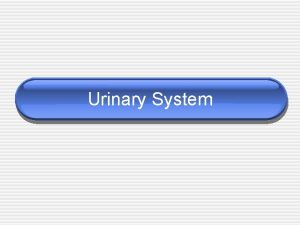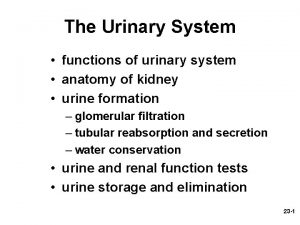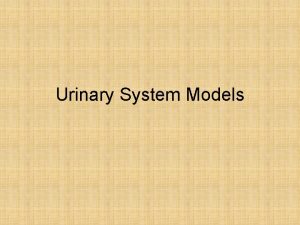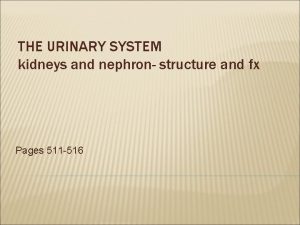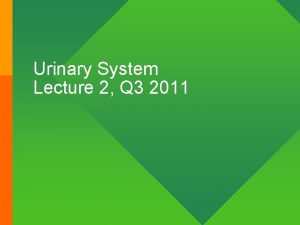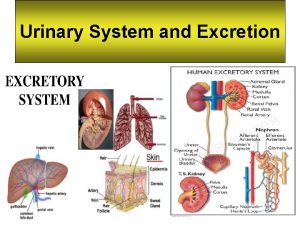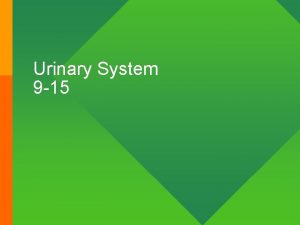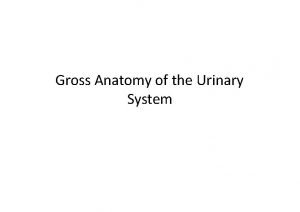Chapter 24 The Urinary System Gross Anatomy Nephron





















































- Slides: 53

Chapter 24: The Urinary System Gross Anatomy Nephron Anatomy Filtration Renal Tubules Urine $100 $100 $200 $200 $300 $300 $400 $400 $500 $500 © 2014 Pearson Education, Inc. Questions by Mark Hollier, Georgia Perimeter College - Clarkston Campus FINAL ROUND

Gross Anatomy: $100 Question The tube that carries urine from the kidney to the urinary bladder is the ____. a. b. c. d. urethra ureter collecting duct renal vein ANSWER © 2014 Pearson Education, Inc. BACK TO GAME

Gross Anatomy: $100 Answer The tube that carries urine from the kidney to the urinary bladder is the ____. a. b. c. d. urethra ureter collecting duct renal vein © 2014 Pearson Education, Inc. BACK TO GAME

Gross Anatomy: $200 Question The renal medulla is also called the ____. a. b. c. d. renal papilla renal columns renal pyramids renal capsule ANSWER © 2014 Pearson Education, Inc. BACK TO GAME

Gross Anatomy: $200 Answer The renal medulla is also called the ____. a. b. c. d. renal papilla renal columns renal pyramids renal capsule © 2014 Pearson Education, Inc. BACK TO GAME

Gross Anatomy: $300 Question Which of the following blood vessels is associated with the nephron? a. b. c. d. Arcuate artery Interlobar vein Cortical radiate vein Efferent arteriole ANSWER © 2014 Pearson Education, Inc. BACK TO GAME

Gross Anatomy: $300 Answer Which of the following blood vessels is associated with the nephron? a. b. c. d. Arcuate artery Interlobar vein Cortical radiate vein Efferent arteriole © 2014 Pearson Education, Inc. BACK TO GAME

Gross Anatomy: $400 Question Which of the following empties urine directly into the renal pelvis? a. b. c. d. Ureter Renal papilla Major calyx Minor calyx ANSWER © 2014 Pearson Education, Inc. BACK TO GAME

Gross Anatomy: $400 Answer Which of the following empties urine directly into the renal pelvis? a. b. c. d. Ureter Renal papilla Major calyx Minor calyx © 2014 Pearson Education, Inc. BACK TO GAME

Gross Anatomy: $500 Question What is the cause of renal ptosis? a. Shortening of the ureter b. Bending of the ureter so that it becomes kinked c. Reduction in the fatty encasement around the kidneys d. Backup of urine from the bladder ANSWER © 2014 Pearson Education, Inc. BACK TO GAME

Gross Anatomy: $500 Answer What is the cause of renal ptosis? a. Shortening of the ureter b. Bending of the ureter so that it becomes kinked c. Reduction in the fatty encasement around the kidneys d. Backup of urine from the bladder © 2014 Pearson Education, Inc. BACK TO GAME

Nephron Anatomy: $100 Question Nephrons are found mostly in the ____. a. b. c. d. renal medulla renal cortex renal capsule renal sinus ANSWER © 2014 Pearson Education, Inc. BACK TO GAME

Nephron Anatomy: $100 Answer Nephrons are found mostly in the ____. a. b. c. d. renal medulla renal cortex renal capsule renal sinus © 2014 Pearson Education, Inc. BACK TO GAME

Nephron Anatomy: $200 Question The renal corpuscle consists of a ____. a. b. c. d. renal tubule glomerulus glomerular capsule both b and c ANSWER © 2014 Pearson Education, Inc. BACK TO GAME

Nephron Anatomy: $200 Answer The renal corpuscle consists of a ____. a. b. c. d. renal tubule glomerulus glomerular capsule both b and c © 2014 Pearson Education, Inc. BACK TO GAME

Nephron Anatomy: $300 Question Which type of nephron plays an important role in producing concentrated urine? a. b. c. d. Renal nephrons Cortical nephrons Medullary nephrons Juxtamedullary nephrons ANSWER © 2014 Pearson Education, Inc. BACK TO GAME

Nephron Anatomy: $300 Answer Which type of nephron plays an important role in producing concentrated urine? a. b. c. d. Renal nephrons Cortical nephrons Medullary nephrons Juxtamedullary nephrons © 2014 Pearson Education, Inc. BACK TO GAME

Nephron Anatomy: $400 Question Podocytes are part of the ____. a. b. c. d. filtration slits juxtaglomerular complex glomerular capsule proximal convoluted tubule ANSWER © 2014 Pearson Education, Inc. BACK TO GAME

Nephron Anatomy: $400 Answer Podocytes are part of the ____. a. b. c. d. filtration slits juxtaglomerular complex glomerular capsule proximal convoluted tubule © 2014 Pearson Education, Inc. BACK TO GAME

Nephron Anatomy: $500 Question Which region of the nephron has abundant microvilli? a. b. c. d. Glomerulus PCT Nephron loop DCT ANSWER © 2014 Pearson Education, Inc. BACK TO GAME

Nephron Anatomy: $500 Answer Which region of the nephron has abundant microvilli? a. b. c. d. Glomerulus PCT Nephron loop DCT © 2014 Pearson Education, Inc. BACK TO GAME

Filtration: $100 Question Which of the following conditions would increase the glomerular filtration rate? a. b. c. d. An increase in colloid osmotic pressure An increase in glomerular hydrostatic pressure An increase in capsular hydrostatic pressure All of the above would increase the GFR ANSWER © 2014 Pearson Education, Inc. BACK TO GAME

Filtration: $100 Answer Which of the following conditions would increase the glomerular filtration rate? a. An increase in colloid osmotic pressure b. An increase in glomerular hydrostatic pressure c. An increase in capsular hydrostatic pressure d. All of the above would increase the GFR © 2014 Pearson Education, Inc. BACK TO GAME

Filtration: $200 Question Which of the following substances would not be found in normal filtrate? a. b. c. d. Albumin Glucose Potassium Urea ANSWER © 2014 Pearson Education, Inc. BACK TO GAME

Filtration: $200 Answer Which of the following substances would not be found in normal filtrate? a. b. c. d. Albumin Glucose Potassium Urea © 2014 Pearson Education, Inc. BACK TO GAME

Filtration: $300 Question Which of the following would be a result of an increase in systemic blood pressure? a. b. c. d. Afferent arterioles constrict Efferent arterioles constrict Afferent arterioles dilate Peritubular capillaries dilate ANSWER © 2014 Pearson Education, Inc. BACK TO GAME

Filtration: $300 Answer Which of the following would be a result of an increase in systemic blood pressure? a. b. c. d. Afferent arterioles constrict Efferent arterioles constrict Afferent arterioles dilate Peritubular capillaries dilate © 2014 Pearson Education, Inc. BACK TO GAME

Filtration: $400 Question What is the NFP if HPgc is 60 mm Hg, OPgc is 35 mm Hg, and HPcs is 15 mm Hg? a. b. c. d. 10 mm Hg 25 mm Hg 45 mm Hg 110 mm Hg ANSWER © 2014 Pearson Education, Inc. BACK TO GAME

Filtration: $400 Answer What is the NFP if HPgc is 60 mm Hg, OPgc is 35 mm Hg, and HPcs is 15 mm Hg? a. b. c. d. 10 mm Hg 25 mm Hg 45 mm Hg 110 mm Hg © 2014 Pearson Education, Inc. BACK TO GAME

Filtration: $500 Question Which of the following glomerular filtration mechanisms involves macula densa cells? a. b. c. d. Tubuloglomerular Hormonal Myogenic Neural ANSWER © 2014 Pearson Education, Inc. BACK TO GAME

Filtration: $500 Answer Which of the following glomerular filtration mechanisms involves macula densa cells? a. b. c. d. Tubuloglomerular Hormonal Myogenic Neural © 2014 Pearson Education, Inc. BACK TO GAME

Renal Tubules: $100 Question Most of the nutrients in the filtrate are reabsorbed in the ____. a. b. c. d. proximal convoluted tubule distal convoluted tubule nephron loop glomerular capsule ANSWER © 2014 Pearson Education, Inc. BACK TO GAME

Renal Tubules: $100 Answer Most of the nutrients in the filtrate are reabsorbed in the ____. a. b. c. d. proximal convoluted tubule distal convoluted tubule nephron loop glomerular capsule © 2014 Pearson Education, Inc. BACK TO GAME

Renal Tubules: $200 Question In the distal convoluted tubule, a ____ is secreted for every sodium ion that is reabsorbed. a. b. c. d. chloride ion bicarbonate ion potassium ion calcium ion ANSWER © 2014 Pearson Education, Inc. BACK TO GAME

Renal Tubules: $200 Answer In the distal convoluted tubule, a ____ is secreted for every sodium ion that is reabsorbed. a. b. c. d. chloride ion bicarbonate ion potassium ion calcium ion © 2014 Pearson Education, Inc. BACK TO GAME

Renal Tubules: $300 Question When glucose spills over into the urine, it has ____. a. b. c. d. been secreted been filtered and secreted exceeded its transport maximum been completely cleared from the blood ANSWER © 2014 Pearson Education, Inc. BACK TO GAME

Renal Tubules: $300 Answer When glucose spills over into the urine, it has ____. a. b. c. d. been secreted been filtered and secreted exceeded its transport maximum been completely cleared from the blood © 2014 Pearson Education, Inc. BACK TO GAME

Renal Tubules: $400 Question If your urine contains fewer potassium ions than your filtrate, then some potassium has been ____. a. b. c. d. filtered and secreted filtered and reabsorbed filtered only secreted only ANSWER © 2014 Pearson Education, Inc. BACK TO GAME

Renal Tubules: $400 Answer If your urine contains fewer potassium ions than your filtrate, then some potassium has been ____. a. b. c. d. filtered and secreted filtered and reabsorbed filtered only secreted only © 2014 Pearson Education, Inc. BACK TO GAME

Renal Tubules: $500 Question Hormonal control of sodium reabsorption is controlled by ____ and occurs in the ____. a. b. c. d. aldosterone, PCT ADH, nephron loop aldosterone, DCT ADH, collecting duct ANSWER © 2014 Pearson Education, Inc. BACK TO GAME

Renal Tubules: $500 Answer Hormonal control of sodium reabsorption is controlled by ____ and occurs in the ____. a. b. c. d. aldosterone, PCT ADH, nephron loop aldosterone, DCT ADH, collecting duct © 2014 Pearson Education, Inc. BACK TO GAME

Urine: $100 Question Which of the following would be an abnormal constituent of urine? a. b. c. d. Sodium Potassium Albumin Urea ANSWER © 2014 Pearson Education, Inc. BACK TO GAME

Urine: $100 Answer Which of the following would be an abnormal constituent of urine? a. b. c. d. Sodium Potassium Albumin Urea © 2014 Pearson Education, Inc. BACK TO GAME

Urine: $200 Question The collecting ducts are ____ to water when the hormone ____ is present. a. b. c. d. permeable; ADH permeable; aldosterone impermeable; ADH impermeable; aldosterone ANSWER © 2014 Pearson Education, Inc. BACK TO GAME

Urine: $200 Answer The collecting ducts are ____ to water when the hormone ____ is present. a. b. c. d. permeable; ADH permeable; aldosterone impermeable; ADH impermeable; aldosterone © 2014 Pearson Education, Inc. BACK TO GAME

Urine: $300 Question Which of the following would be an abnormal p. H for urine? a. b. c. d. 5. 0 6. 0 8. 0 11. 0 ANSWER © 2014 Pearson Education, Inc. BACK TO GAME

Urine: $300 Answer Which of the following would be an abnormal p. H for urine? a. b. c. d. 5. 0 6. 0 8. 0 11. 0 © 2014 Pearson Education, Inc. BACK TO GAME

Urine: $400 Question The portion of the nephron that maintains the hypertonicity of the renal medulla is the ____. a. b. c. d. proximal convoluted tubule glomerulus nephron loop distal convoluted tubule ANSWER © 2014 Pearson Education, Inc. BACK TO GAME

Urine: $400 Answer The portion of the nephron that maintains the hypertonicity of the renal medulla is the ____. a. b. c. d. proximal convoluted tubule glomerulus nephron loop distal convoluted tubule © 2014 Pearson Education, Inc. BACK TO GAME

Urine: $500 Question When urine enters the collecting duct, it is ____ to the blood. a. b. c. d. hypotonic hypertonic isosmotic ANSWER © 2014 Pearson Education, Inc. BACK TO GAME

Urine: $500 Answer When urine enters the collecting duct, it is ____ to the blood. a. b. c. d. hypotonic hypertonic isosmotic © 2014 Pearson Education, Inc. BACK TO GAME

FINAL ROUND Question Which part of the nephron employs a countercurrent mechanism? a. b. c. d. Glomerulus Nephron loop Distal convoluted tubule Juxtaglomerular complex ANSWER © 2014 Pearson Education, Inc. BACK TO GAME

FINAL ROUND Answer Which part of the nephron employs a countercurrent mechanism? a. b. c. d. Glomerulus Nephron loop Distal convoluted tubule Juxtaglomerular complex © 2014 Pearson Education, Inc. BACK TO GAME
 Ureter diameter
Ureter diameter Abnormal constituents of urine
Abnormal constituents of urine Cortical nephron
Cortical nephron Kidney location in human body
Kidney location in human body Gross anatomy of skeletal system
Gross anatomy of skeletal system Tabel menabung 1 juta perbulan
Tabel menabung 1 juta perbulan Anatomy of the urinary tract
Anatomy of the urinary tract Red and white blood cells difference
Red and white blood cells difference Kidneys location and structure figure 15-1
Kidneys location and structure figure 15-1 Hyperproteinuria definition
Hyperproteinuria definition The urinary system chapter 30
The urinary system chapter 30 Chapter 15 the urinary system figure 15-3
Chapter 15 the urinary system figure 15-3 Chapter 20 urinary/excretory system
Chapter 20 urinary/excretory system The urinary system chapter 15
The urinary system chapter 15 Chapter 9 the urinary system learning exercises answer key
Chapter 9 the urinary system learning exercises answer key Afferent arteriole and efferent arteriole
Afferent arteriole and efferent arteriole Gross anatomy of the lungs
Gross anatomy of the lungs Gross anatomy of the large intestine
Gross anatomy of the large intestine Pontomedullary junction
Pontomedullary junction Gross anatomy
Gross anatomy Gross anatomy of a long bone
Gross anatomy of a long bone Cow eye pupil
Cow eye pupil Choroid cow eye
Choroid cow eye Gastric gland
Gastric gland Sheeps brain
Sheeps brain Introduction of urinary system
Introduction of urinary system Urinary system interesting facts
Urinary system interesting facts Pig male reproductive system
Pig male reproductive system Urinary system model
Urinary system model Urinary system fun fact
Urinary system fun fact Branching gills
Branching gills Urinary system powerpoint
Urinary system powerpoint Proximal convoluted tubule histology
Proximal convoluted tubule histology Functions of adh
Functions of adh Hysterosalpingography
Hysterosalpingography Defination of urinary system
Defination of urinary system Excretory system
Excretory system Rat internal organs
Rat internal organs Rat urinary system
Rat urinary system Vena cava function in excretory system
Vena cava function in excretory system Figure 15-4 is a diagram of a nephron
Figure 15-4 is a diagram of a nephron Vasa recta
Vasa recta Does the urinary system regulate blood pressure
Does the urinary system regulate blood pressure Urinary system
Urinary system Normal constituents of urine
Normal constituents of urine Normal and abnormal constituents of urine
Normal and abnormal constituents of urine Peritubular capillaries
Peritubular capillaries Cystolith medical term
Cystolith medical term Uti
Uti Arneriole
Arneriole Youtube urinary system
Youtube urinary system Anatomical structure of urinary system
Anatomical structure of urinary system Chapter 22 urinary elimination
Chapter 22 urinary elimination Chapter 25 urinary catheters
Chapter 25 urinary catheters
